Love is sharing!
Serpstat vs Semrush are great SEO tools for content marketers who want to create and improve high-quality content that ranks well on search engines.
Table of Contents
ToggleWith ten years of experience in SEO, I’ve looked at both platforms in detail, showing what they do and how they’re different.
This information will help you choose the right one for you, depending on what you need. So, when it comes to picking between Semrush vs Serpstat, which one gives you more bang for your buck? Let’s find out.
Overview of Semrush vs Serpstat
What Is Serpstat?
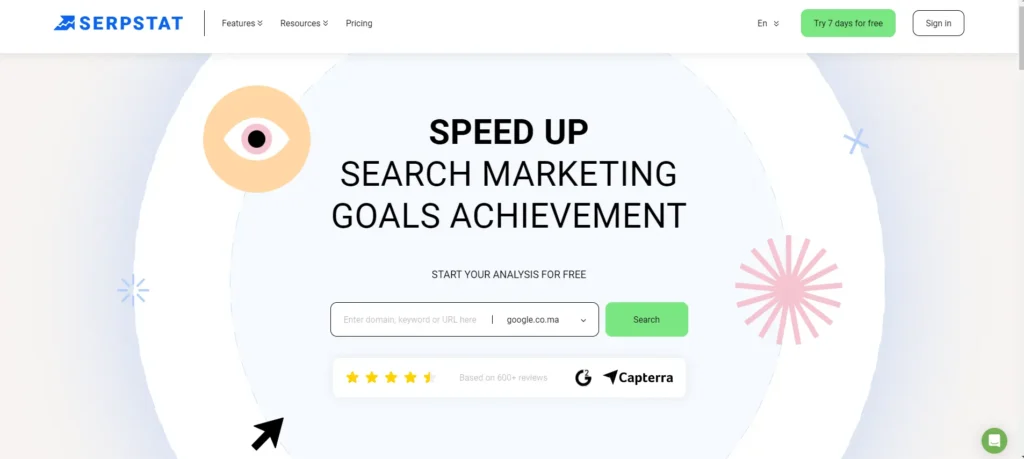
Serpstat is a comprehensive platform designed for professionals who want the best tool to manage their online presence, PPC, content marketing, SEO, and more.
Started in 2013 as a simple keyword research tool, Serpstat has grown into a global leader. It’s been praised as the top SEO tool on Product Hunt and holds the title of the best-selling tool ever on Appsumo.
With over 200,000 users, professionals rely on Serpstat to streamline their work and boost efficiency.
What is Semrush?

Semrush is a widely-used digital marketing tool for individuals and businesses to boost their online presence and understand current marketing trends on the internet.
It’s particularly useful for digital marketers and SEO agencies, offering features like SEO, PPC, Keyword Difficulty, Search Volume, Competitive Research, PR, Content Marketing, Marketing Insights, and Campaign Management.
Starting in 2008 with a small team of SEO and IT specialists, Semrush has grown into a powerful platform used in 142 countries.
Serpstat vs Semrush: User Interface & Ease of Use
The way a tool looks and works can really affect how well a marketer can do their job.
I think both SEMrush and Serpstat are pretty easy for newbies to figure out.
But Serpstat’s dashboard is just nicer to use.
To show you what I mean, let’s take a quick look at both platforms:
Semrush
Semrush is not difficult to use. But when you compare it with Serpstat, it starts to look a bit old-fashioned and messy.
Still, Semrush deserves credit for squeezing in lots of features into a small dashboard. You can find everything you need, like domain analytics tools and reports, in the left menu.
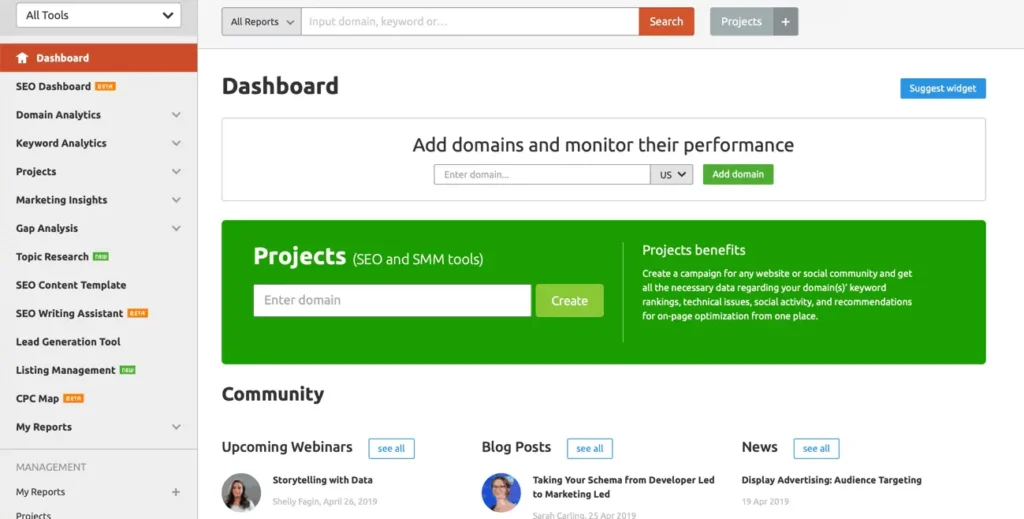
To start using the tool, you just need to type a domain address, keyword, or page URL into the top search bar. Then, click the orange ‘Search‘ button to begin.
If you entered a domain, Semrush will show you a detailed overview page with tons of information.
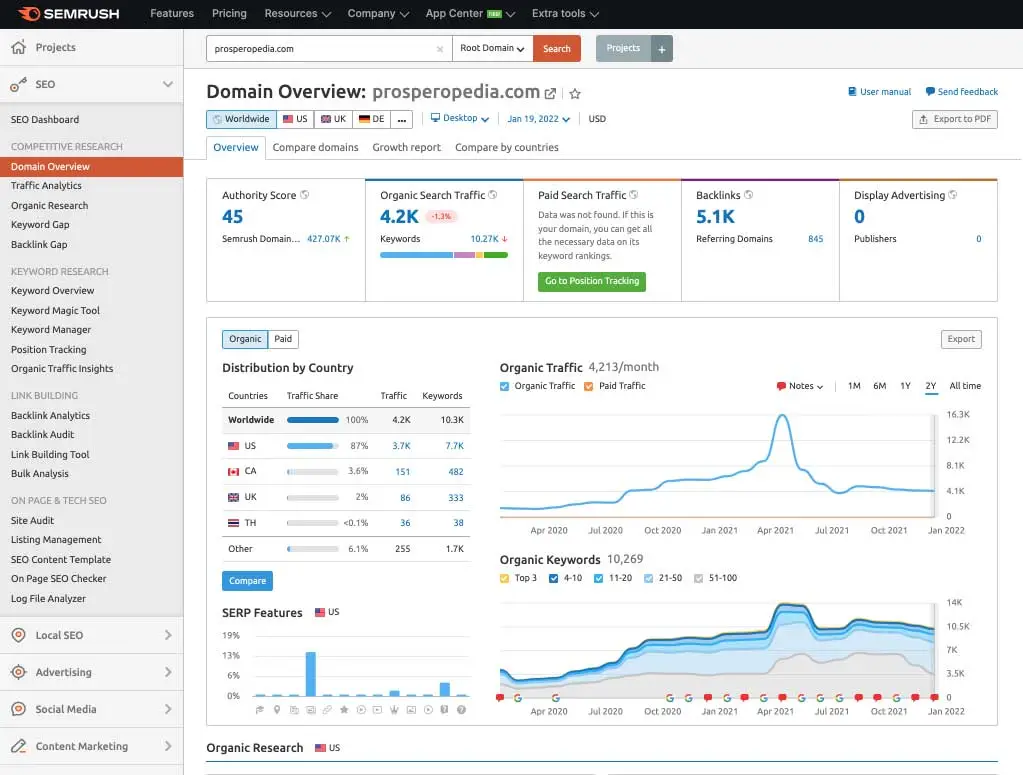
Some key pieces of information include the site’s organic traffic, backlink profile size, top organic keywords, and some sample ads.
SEMrush tends to put a lot of information in small spaces on the screen. Personally, I’m okay with it, but some bloggers might prefer data to be presented in a more organized way for better visibility.
If you type in a keyword, SEMrush will take you straight to the overview page under ‘Keyword Analytics.’ Here, you’ll find lots of useful data, from the keyword’s organic search volume to a list of related keywords.
You’ll get to explore more of SEMrush’s keyword research features later.
Finally, if you enter a page URL, SEMrush will show you the “Organic Research” analysis page. Here, you’ll find information about the page’s organic keywords, traffic trends, position changes, and more.
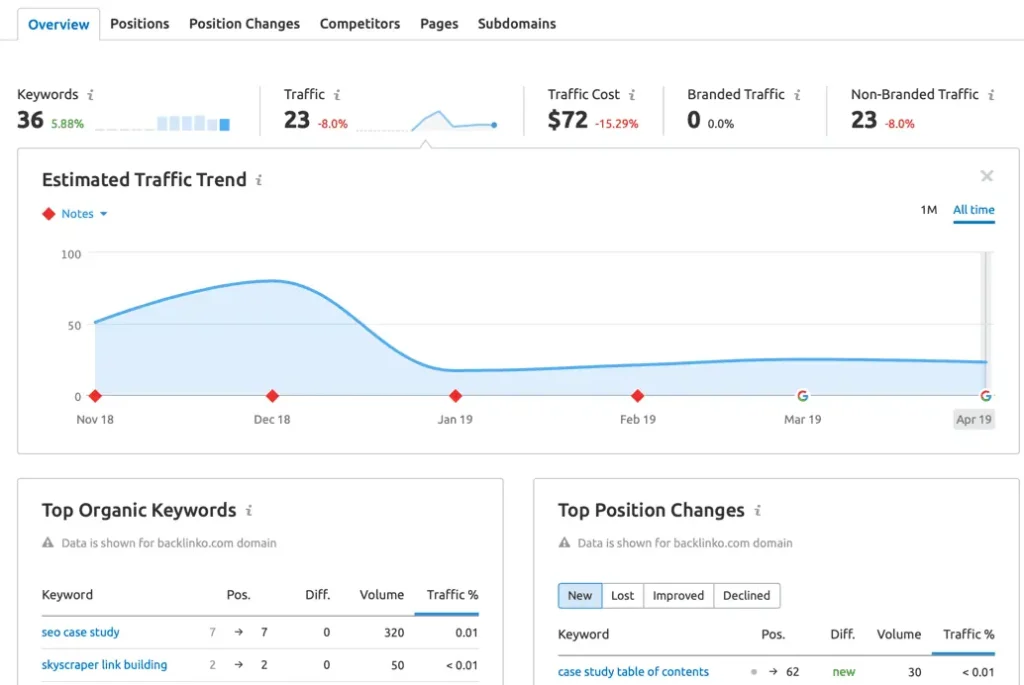
Serpstat
Now, let’s check out Serpstat after looking at Semrush.
The first thing you’ll see is that Serpstat’s design looks more polished.
Your starting point is the “List of Projects” page. Here, you can easily access all the projects you’ve saved on the platform with just one click.
To quickly analyze something with Serpstat, just type a keyword, domain, URL, or URL prefix into the search bar and click ‘Search.’
You might see a drop-down menu where you can choose the specific type of information you’re looking for. But you don’t really need to use it since Serpstat will figure out the right type automatically based on what you enter.
Let’s say you type in a domain address.
Like Semrush, Serpstat will take you to a page showing the domain’s organic traffic, keywords, and backlink information. The difference you’ll notice is that the information is more spread out and organized.
This small change in how things are shown can make a big difference in your research experience. It can help you avoid feeling overwhelmed with too much information. However, seasoned Semrush users are likely accustomed to the compact layout and may not find it bothersome.
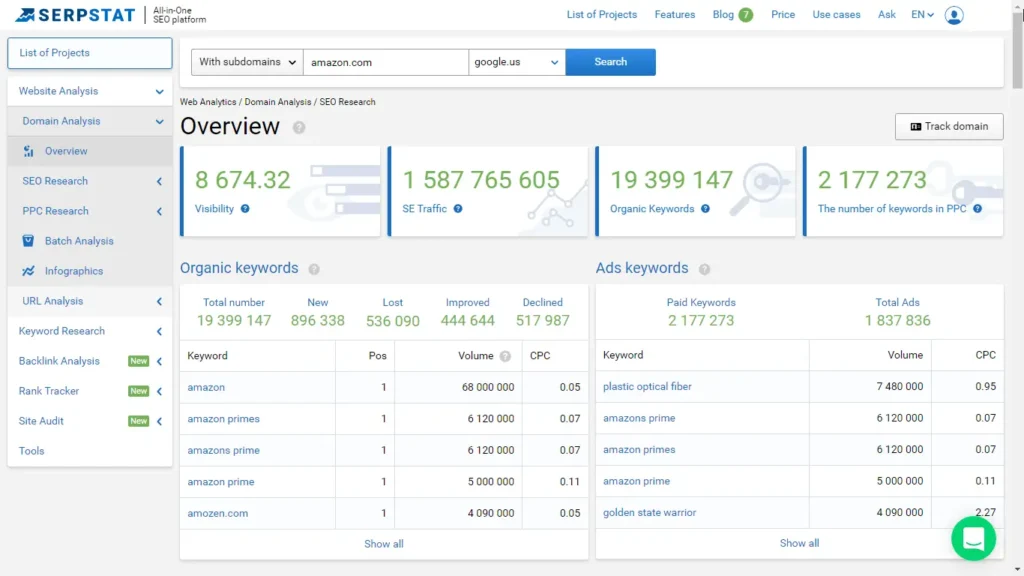
Serpstat also uses pictures and charts to show where a website’s keywords are ranked and how its traffic has changed over a year. This helps you see everything about a website’s online presence.
When you type in a word, Serpstat shows a page called “Keyword Research” that neatly lists important information. This includes how many times people search for the word, how much it costs for ads, how hard it is to rank for, and other similar words.
For individual web pages, Serpstat only shows the most important information on one page. If you want to see more details, you have to click on other pages in the ‘URL Analysis’ section.
Serpstat vs Semrush: Key Features
1. Rank Tracker
Serpstat
Serpstat’s rank tracker is an online tool that helps you monitor your position on search engine results pages (SERPs).
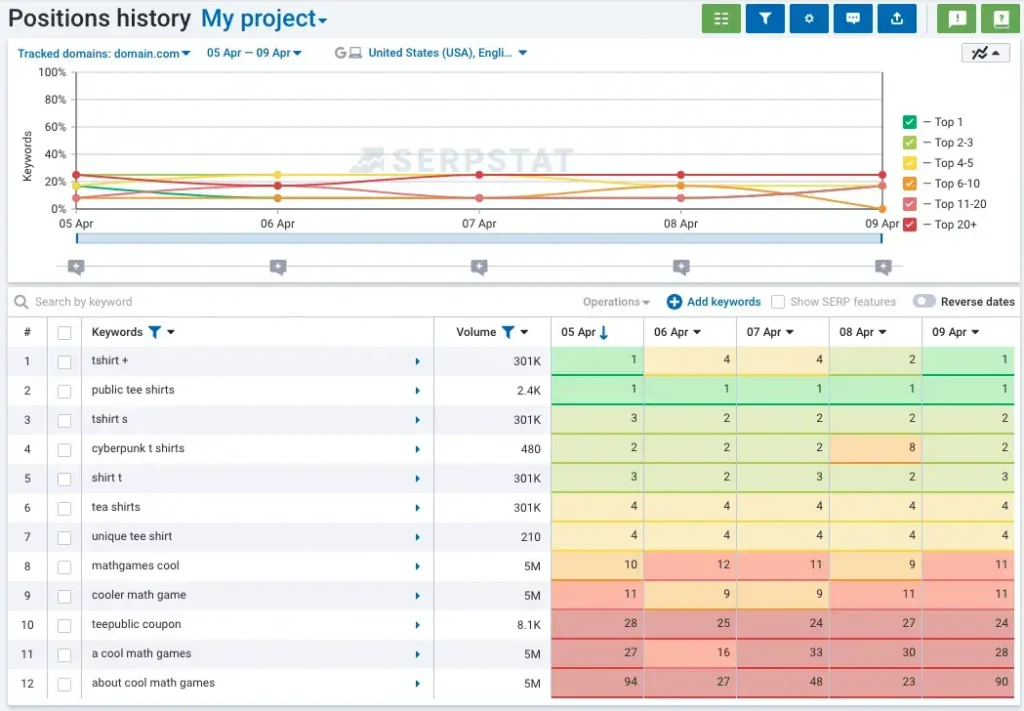
You can gather valuable insights into the keywords your website and competitors rank for, and track how their positions change over time.
For maximizing revenue from your website, you can use this tool to monitor your position in contextual advertising and discover keywords your competitors use for paid ads.
To access this tool, log in and activate the free 7-day trial, after which you can choose any paid plan.
Semrush
Semrush’s rank tracker is a tool for monitoring your website’s rankings.
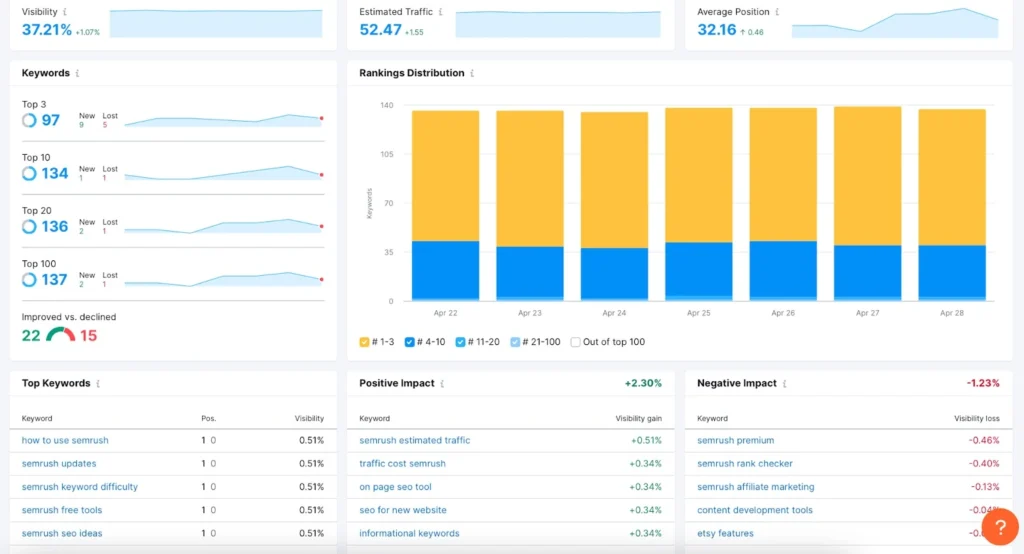
It provides various data visualizations, including a snippet report, and offers in-depth filtering options.
To use it, simply enter your domain and click “set up tracking.” You’ll then receive information about your domain’s position, visibility, estimated traffic, and other SERP features.
2. Site Audit
Serpstat
Serpstat has a tool called the SEO audit feature. This tool looks at your website to find any problems with how it’s set up for search engines. It checks if you have things like titles, descriptions, or images missing or broken.
The SEO audit tool checks your website regularly. It gives you a report that shows you how many problems it found. Then, you can fix them to make your website better for search engines.
Semrush
Semrush offers a free SEO audit tool to identify issues within your website and address them effectively.
This tool provides technical SEO reports to assess your website’s crawlability, performance, and internal linking issues.
Additionally, Semrush’s SEO audit tool ensures the correct implementation of “hreflang” tags for multilingual websites, ensuring Google displays the appropriate version to the audience.
3. Backlinks Analysis (Serpstat vs Semrush)
Serpstat
Serpstat offers a useful tool: a backlink checker. This helps strengthen your backlink profile, analyze your competitors’ links, select the best donors, and remove poor-quality backlinks.
You can also check domain rankings with Serpstat to find suitable backlink donors. It allows you to manage your website’s link anchors, discover unique links and top sources, and compare backlink metrics for different domains.
Semrush
With Semrush, you can analyze your backlinks using its analytics tool. This tool checks your website profile and your competitors’ to see how well you’re competing and if you can get good backlinks.
It also gives reports on domains with similar backlinks to yours and shows your competitors’ best-performing pages. This way, you can get quality backlinks for your website.
4. Keyword Research Tools (Serpstat vs Semrush)
Serpstat
Serpstat offers a fantastic keyword research tool. It helps you discover the best organic keywords and ideas for your website.
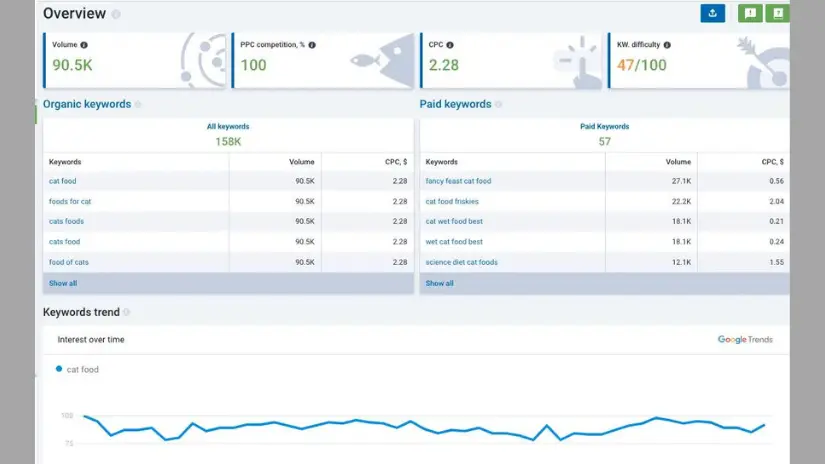
This tool looks at lots of keywords, gathers your competitors’ most successful ones, and tells you how hard each keyword is to rank for.
It also gives you relevant keyword suggestions in your niche, so your website can reach more people.
Semrush
Semrush offers a keyword research tool called the “Keyword Magic Tool.” This tool helps you with keyword research and analysis to create a special SEO plan.
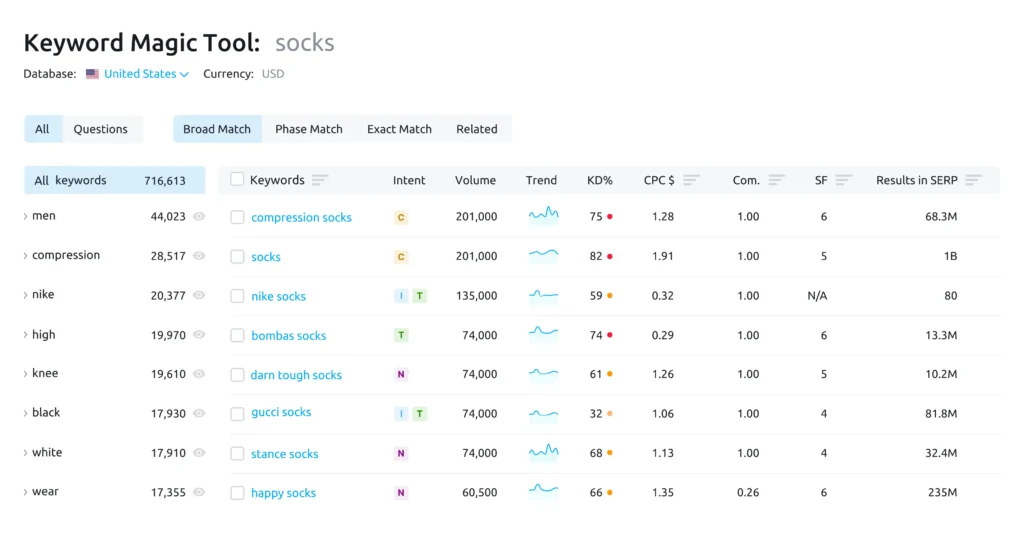
When you search for a keyword using the Keyword Magic Tool, you’ll find related keywords and phrases that can bring lots of traffic to your website.
You’ll also see details like how much ad traffic there is, the price of ad clicks, and the total number of ads related to that keyword.
5. Competitor Analysis
Serpstat
Serpstat provides a tool for analyzing your competitors. It looks at their websites in SEO and PPC to find out who the top competitors are and where they get their traffic from.
With this tool, you can compare the keywords and traffic of your competitors. This helps you figure out how to copy their successful strategies.
Semrush
When you want to check out your competition, Semrush offers four tools to help you do just that. These tools are the traffic analytics tool, the organic research tool, the advertising research tool, and the social media tracker tool.
Using these tools, you can learn specific details about your competitors, like where their traffic comes from, how many visitors quickly leave their site, their social media pages, and how they advertise.
“The main goal of SEO keyword research is to rank higher on search engines like Google, get more people visiting your site without paying for ads, and catch the attention of visitors who might stick around and become regular customers.” – Jay Bae, Founder and Head of Growth at Hedley Digital.
6. Text Analytics
Serpstat
Serpstat has a tool called text analytics that pays attention to the content you publish on your website. It checks for mistakes in writing, makes sure you haven’t left out any important keywords, and deals with any spam.
This tool also makes sure your content sounds natural and is organized well, using the right keywords to attract the right people to your website.
Semrush
Semrush has a tool called the SEO writing assistant. It looks at your text to make sure it’s good for search engines.
This tool also makes sure your writing is easy to read, sounds the same throughout, and doesn’t have any mistakes or copied content.
You can use important keywords and extra features to help make your content better for search engines.
7. Pricing (Serpstat vs Semrush)
Serpstat
Serpstat has four pricing plans: the Individual plan costs $50 per month, the Team plan costs $100 per month, and the Agency plan costs $410 per month. You can also save 20% by subscribing annually instead of monthly.
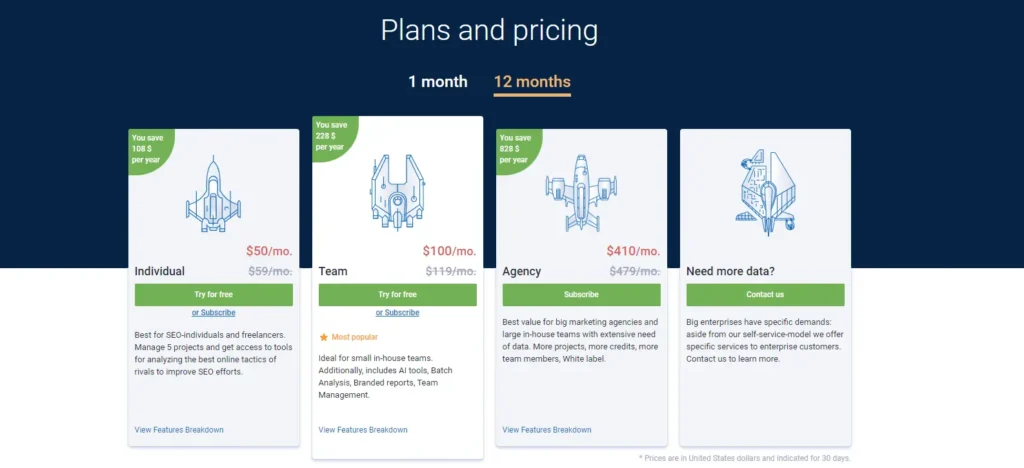
Serpstat offers the option to contact them for specific services not included in the listed price plans.
Semrush
Semrush offers three pricing plans on a monthly subscription basis. The Pro plan starts at $129.95 per month, the Guru plan at $249.95 per month, and the Business plan at $499.95 per month. You can save up to 17% by opting for annual payments.
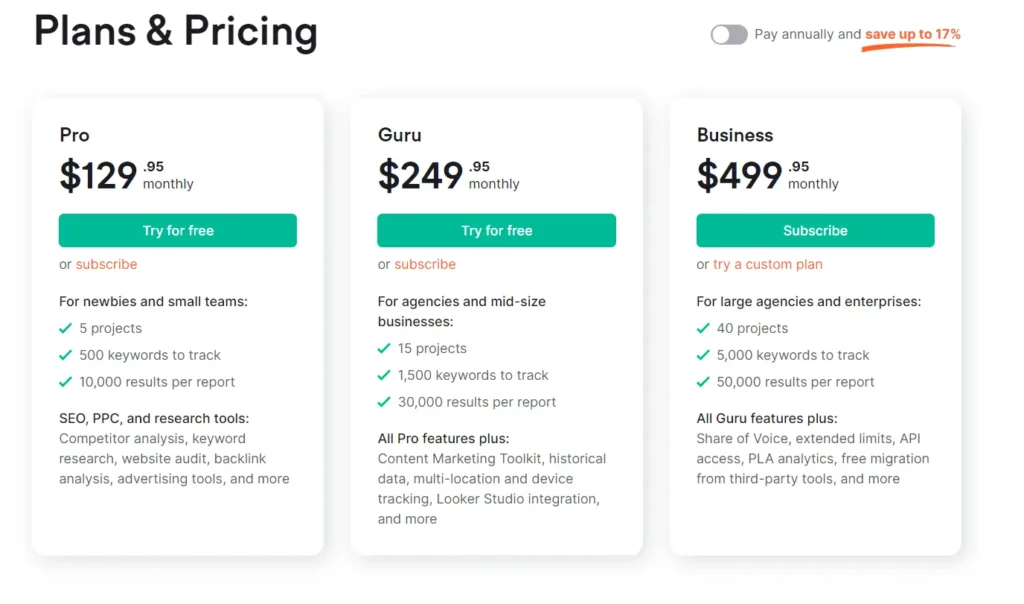
Semrush vs Serpstat: The Ultimate Winner
Serpstat and Semrush are tools that help people and businesses improve their websites for search engines.
Both tools cover everything you need for content and website improvement. However, I always prefer Semrush.
It works well, gives excellent results, and helps you rank high on search engines.
Love is sharing!




